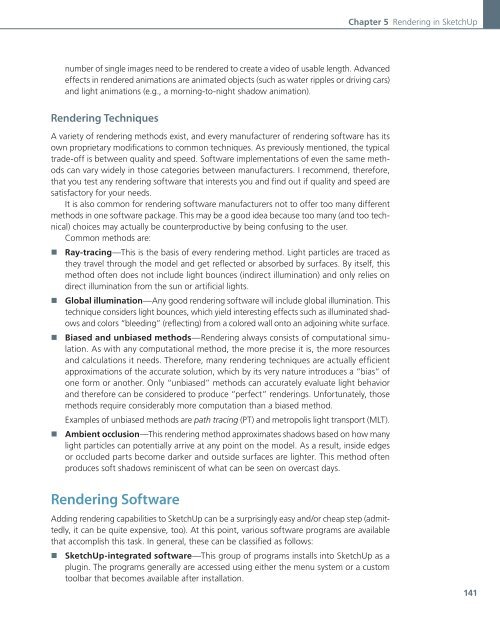Architectural_Design_with_SketchUp
You also want an ePaper? Increase the reach of your titles
YUMPU automatically turns print PDFs into web optimized ePapers that Google loves.
Chapter 5 Rendering in <strong>SketchUp</strong><br />
number of single images need to be rendered to create a video of usable length. Advanced<br />
effects in rendered animations are animated objects (such as water ripples or driving cars)<br />
and light animations (e.g., a morning-to-night shadow animation).<br />
Rendering Techniques<br />
A variety of rendering methods exist, and every manufacturer of rendering software has its<br />
own proprietary modifications to common techniques. As previously mentioned, the typical<br />
trade-off is between quality and speed. Software implementations of even the same methods<br />
can vary widely in those categories between manufacturers. I recommend, therefore,<br />
that you test any rendering software that interests you and find out if quality and speed are<br />
satisfactory for your needs.<br />
It is also common for rendering software manufacturers not to offer too many different<br />
methods in one software package. This may be a good idea because too many (and too technical)<br />
choices may actually be counterproductive by being confusing to the user.<br />
Common methods are:<br />
NN<br />
NN<br />
NN<br />
NN<br />
Ray-tracing—This is the basis of every rendering method. Light particles are traced as<br />
they travel through the model and get reflected or absorbed by surfaces. By itself, this<br />
method often does not include light bounces (indirect illumination) and only relies on<br />
direct illumination from the sun or artificial lights.<br />
Global illumination—Any good rendering software will include global illumination. This<br />
technique considers light bounces, which yield interesting effects such as illuminated shadows<br />
and colors “bleeding” (reflecting) from a colored wall onto an adjoining white surface.<br />
Biased and unbiased methods—Rendering always consists of computational simulation.<br />
As <strong>with</strong> any computational method, the more precise it is, the more resources<br />
and calculations it needs. Therefore, many rendering techniques are actually efficient<br />
approximations of the accurate solution, which by its very nature introduces a “bias” of<br />
one form or another. Only “unbiased” methods can accurately evaluate light behavior<br />
and therefore can be considered to produce “perfect” renderings. Unfortunately, those<br />
methods require considerably more computation than a biased method.<br />
Examples of unbiased methods are path tracing (PT) and metropolis light transport (MLT).<br />
Ambient occlusion—This rendering method approximates shadows based on how many<br />
light particles can potentially arrive at any point on the model. As a result, inside edges<br />
or occluded parts become darker and outside surfaces are lighter. This method often<br />
produces soft shadows reminiscent of what can be seen on overcast days.<br />
Rendering Software<br />
Adding rendering capabilities to <strong>SketchUp</strong> can be a surprisingly easy and/or cheap step (admittedly,<br />
it can be quite expensive, too). At this point, various software programs are available<br />
that accomplish this task. In general, these can be classified as follows:<br />
NN<br />
<strong>SketchUp</strong>-integrated software—This group of programs installs into <strong>SketchUp</strong> as a<br />
plugin. The programs generally are accessed using either the menu system or a custom<br />
toolbar that becomes available after installation.<br />
141

















